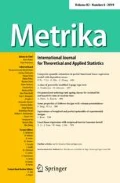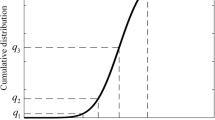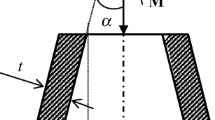Abstract
In the early stage of exploring a complex system, a preliminary experiment is used to capture the key characteristics of the model. Symmetrical global sensitivity analysis (SGSA) is one such experiment that explores the symmetrical structure of model by decomposing the model into independent symmetric functions. However, the existing experimental plans for SGSA rely on deterministic computational models that produce unique values of outputs when executed for specific values of inputs. In this paper, the problem of designing experiments for non-parametric SGSA is considered. Here the phrase “non-parametric” refers to model outputs containing random errors. The main result in the paper shows that a symmetrical design with certain constraints achieves A-optimum for the estimation of each output element function, and guarantees the superiority of the SGSA result. The statistical properties of non-parametric SGSA based on the optimal designs are further discussed, showing that the non-influential sensitivity indices can be estimated with low bias and volatility. Two explicit structures of the optimal designs are obtained. The optimality of the derived design is validated by simulation in the end.
Similar content being viewed by others
References
Fang K, Liu M, Zhou Y (2011) Design and Modeling of Experiments. Higher Education Press, Beijing
Harenberg D, Marelli S, Sudret B, Winschel V (2019) Uncertainty quantification and global sensitivity analysis for economic models. Quantitative Econ 10:1–41
Hickernell FJ (1998) Lattice rules: how well do they measure up? In: Hickernell P, Larcher G (eds) Random and Quasi-Random Point Sets. Springer, New York, pp 109–168
Iooss B, Lemaitre P (2015) A review on global sensit anal methods. Operations Research/ Computer Science Interfaces Series, Springer, Boston, MA
Luo C, Zhang Y (2016) Symmetrical Design of Experiment in Global Sensitivity Analysis Based on ANOVA High-Dimensional Model Representation. Commun in Statistics-Simulation and Comput 45:48–72
Morris M (1991) Factorial Sampling Plans for Preliminary Computational Experiments. Technometrics 33:161–174
Oakley JE, O’Hagan A (2004) Probabilistic sensitivity analysis of complex models: a Bayesian approach. J of the Royal Statistical Soc: Ser B 66:751–769
Saltelli A, Tarantola S, Chan KPS (1999) A quantitative model-independent method for global sensitivity analysis of model output. Technometrics 25:197–233
Saltelli A, Ratto M, Andres T, Campolongo F, Cariboni J, Gatelli D, Saisana M, Tarantola S (2008) Global sensitivity analysis-The primer. John Wiley and Sons, Chichester
Saltelli A, Annoni P, Azzini I, Campolongo F, Ratto M, Tarantola S (2010) Variance based sensitivity analysis of model output. Design and estimator for the total sensitivity index. Comput Phys Commun 181:259–270
Searle SR (1971) Linear models. Wiley, New York, USA
Sobol IM (1993) Sensitivity analysis for nonlinear mathematical models. Math Modeling and Comput Experiment 1:407–414
Sobol IM (2001) Global sensitivity indices for nonlinear mathematical models and their Monte Carlo estimates. Math and Comput in Simulation 55:271–280
Wang X, Fang K (2003) The effective dimension and quasi-Monte Carlo integration. J of Complexity 19:101–124
Wang X, Tang Y, Zhang Y (2012) Orthogonal Arrays for Estimating Global Sensitivity Indices of Non-parametric Models based on ANOVA High-dimensional Model Representation. J of Statistical Planning and Inference 142:1801–1810
Wang X, Chen X (2017) Symmetrical design for symmetrical global sensitivity analysis of model output. J of Statistical Comput and Simulation 87:2738–2759
Wang X, Tsung F, Li W, Xiang D, Cheng C (2021) Optimal space-filling design for symmetrical global sensitivity analysis of complex black-box models. Applied Math Modelling 100:303–319
Zhang Y, Pang S, Jiao Z, Zhao W (1998) Group partition and systems of orthogonal idempotents. Linear Algebr and its Appl 278:249–262
Acknowledgements
The work is supported by Natural Science Foundation of China (Nos. 11971204, 12071497, 11601538), National Statistical Science Research Project (No. 2020LY014), Natural Science Foundation of Jiangsu Province of China (No. BK20200108) and the Zhongwu Youth Innovative Talent Program of Jiangsu University of Technology.
Author information
Authors and Affiliations
Corresponding author
Ethics declarations
Conflict of interest
On behalf of all authors, the corresponding author states that there is no conflict of interest.
Additional information
Publisher's Note
Springer Nature remains neutral with regard to jurisdictional claims in published maps and institutional affiliations.
Appendix
Appendix
1.1 Proof of Property 2.2
We first choose a \({\varvec{\gamma _{1}}}\) from H. Then from the definition of symmetrical design, each \({\varvec{\gamma _{1}}}\sigma \) (\(\sigma \in G\)) is in H.
Denote the matrix that merges the same rows of
as \(H^{{\varvec{\gamma _{1}}}},\) and secondly choose a \({\varvec{\gamma _{2}}}\) from H that is not in \(H^{{\varvec{\gamma _{1}}}}.\) Then each \({\varvec{\gamma _{2}}}\sigma ,\) \(\sigma \in G\) is in H but not in \(H^{{\varvec{\gamma _{1}}}}.\) Otherwise, suppose \({\varvec{\gamma _{2}}}\pi \in H^{{\varvec{\gamma _{1}}}},\) then \(({\varvec{\gamma _{2}}}\pi )\pi ^{-1}={\varvec{\gamma _{2}}}\in H^{{\varvec{\gamma _{1}}}}.\)
And so on, H can be expressed as the form of Property 2.2. \(\square \)
1.2 Proof of Lemma 3.1
Denote the independent parameters of \(f_l({\varvec{X}})\) as \({\varvec{\beta _l}},\) then based on the restrictions of \(f_l({\varvec{X}})\), a matrix \(C_l\) with rank \(d_{l}\) can be obtained such that
It follows that Model (2) can be transformed into the linear model:
where \(C=\left( C_{0}, C_{1}, \ldots , C_{k}\right) \) and \(\varvec{\beta }=\left( \varvec{\beta }_{0}^{\prime }, \varvec{\beta }_{1}^{\prime }, \ldots , \varvec{\beta }_{\varvec{k}}^{\prime }\right) ^{\prime }.\)
If H is feasible, then \({\varvec{\beta }}\) is estimable, and C has full column rank. The least-square estimation of \(\beta \) is \(\widehat{\beta }=\left( C^{\prime } C\right) ^{-1} C^{\prime } {\varvec{Y}}.\) Let
where \(I_{d_l}\) is the identity matrix of order \(d_l.\) Then by Gauss-Markov theorem,
is the best linear unbiased estimation of \(f_{l}(\varvec{X})\) and
From Lemma 2.2 of Wang et al. (2012), we can be obtain that
and
Thus
\(\square \)
1.3 Proof of Theorem 3.1
First, we introduce Lemma 5.1 to show the Theorem 3.1.
Lemma 5.1
For symmetrical designs, if \(\chi _{1}(\sigma )\equiv 1\) and \(\sum \nolimits _{\sigma \in G}\chi _{l}(\sigma )=0\) for \(l=2,\ldots ,k,\) then we have \({\varvec{M_l}}f_l({\varvec{X}})=f_l({\varvec{X}})\) for \(l=1,\ldots ,k.\)
Proof
From the definition of \({\varvec{M_l}},\) we have
Noting that \((\sum \nolimits _{\sigma \in G}\chi _l(\sigma ))(\sum \nolimits _{i=1}^{n}f_l({\varvec{X_i}}))=0\) based on the constrain of the model and the condition of \(\chi _l\), the above expression equals
From the symmetry of \(f_l,\) we have
Thus
\(\square \)
Then we give the proof of Theorem 3.1.
From Lemma 5.1 and Property 2.1, we have
Thus \(\widehat{f_{l}({\varvec{X}})}\) is unbiased.
Furthermore, we have from Lemma 3.1 that,
for any \({\varvec{\beta _l}}.\) Thus \(R(C_l)\subset R({\varvec{M_l}}),\) and
Given \(rk({\varvec{M_l}})\le d_l,\) we obtain \(rk({\varvec{M_l}})=d_l,\) and
It follows that
\(\square \)
1.4 Proof of Corollary 3.1
From the proof of Theorem 3.1, we just need to prove that \(rk({\varvec{M_l}})=d_l.\)
Since \({\varvec{M_l}}\) is a projection matrix, we have
Suppose there are t rows of H satisfying (ii) of the corollary and \(n-t\) rows satisfying (i) with w pathways. Obviously, each of the w pathways constitute a block of run size |G|.
Then from the definition of \(P(\sigma ),\) we obtain that \(P(e)=I_n\) and the diagonal elements of \(P(\sigma )\) have t numbers of 1 and \(n-t\) numbers of 0. It follows that \(trP(e)=n=w|G|+t\) and \(trP(\sigma )=t\) for \(\sigma \ne e.\)
\({\varvec{(i).}}\) For \(l=1,\) we obtain from \(\chi _{1}(\sigma )\equiv 1\) that
On the other hand, based on constrain (4), each \(\{f_1({\varvec{X_i}}), f_1({\varvec{X_i}}\sigma _1),\ldots ,f_1({\varvec{X_i}}\sigma _{g})\}\) has one independent parameter, i.e., there are \(w+t\) independent parameters. Furthermore, given constrain (3)
there are \(w+t-1\) independent parameters in \(f_1({\varvec{X}}),\) and
\({\varvec{(ii).}}\) For \(l=2,\ldots ,k,\) we obtain from the conditions \(\sum \nolimits _{\sigma \in G}\chi _{l}(\sigma )=0\) and \(\chi _{l}(e)=1\) that
For \(\sigma \ne e,\) suppose the first t diagonal elements of \(P(\sigma )\) are non-zero, then
It follows that
Furthermore, for the \({\varvec{X_t}}\) whose corresponding \({\varvec{\alpha }}\) satisfies (ii) of the corollary, we have
For the remaining \({\varvec{X_t}}\)s, the corresponding \({\varvec{\alpha }}\) satisfy (i) of the corollary, and compose w pathways. Suppose each pathway corresponds to \({\varvec{F}}=(f_l({\varvec{X_i}}), f_l({\varvec{X_i}}\sigma _1),\ldots ,f_l({\varvec{X_i}}\sigma _{g}))^{'},\) then it has \({\varvec{F}}={\varvec{A_lF}}\) from constrain (4) of the model. Given the condition \(rk(I_{|G|}-{\varvec{A_l}})=g\) in (II), there is one independent parameter in each \(\{f_l({\varvec{X_i}}), f_l({\varvec{X_i}}\sigma _1),\ldots ,f_l({\varvec{X_i}}\sigma _{g})\}.\) Then there are w independent parameters in \(f_l({\varvec{X}}).\)
Therefore,
for \(l=2,\ldots ,k.\) \(\square \)
Rights and permissions
About this article
Cite this article
Chen, X., Gai, Y. & Wang, X. A-optimal designs for non-parametric symmetrical global sensitivity analysis. Metrika 86, 219–237 (2023). https://doi.org/10.1007/s00184-022-00872-3
Received:
Accepted:
Published:
Issue Date:
DOI: https://doi.org/10.1007/s00184-022-00872-3




